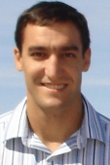
David Atienza, Associate Professor, EPFL, Switzerland
The progress in microelectronics has enabled the miniaturization of processing elements, radio transceivers, and sensing elements of a large array of physiological phenomena. This situation has made plausible to realize low cost, low power, miniaturized, yet smart sensor nodes needed to develop wireless body-area sensor networks (WBSN). However, the inherent resource-constrained nature of these systems, coupled with the harsh operating conditions and stringent autonomy requirements, pose important design challenges to make them provide automated analysis for complex biological signals. This talk addresses ultra-low power design of next-generation smart WBSN platforms for multimodal bio-signal monitoring systems, and highlights the unsustainable energy cost incurred by the relatively straightforward wireless streaming of raw sensor data. To achieve the extended autonomy required by long-term ambulatory monitoring, this talk advocates for enabling more embedded intelligence onboard these sensor nodes through a new system-level design approach. This approach exploits the bio-signal features to apply the new compressive sensing paradigm in the design of specialized near-threshold computing and memory blocks in order to deploy ultra-low power (ULP) multi-core processing architectures for automated bio-signals analysis on WBSN. To illustrate the effectiveness of this approach, this talk focuses on cardiac monitoring systems and show how it is possible to achieve multi-modal wearable systems based on wearable ULP electrocardiogram (ECG) arrhythmia detection systems that can operate autonomously for long periods of time and support a graceful quality degradation of the system output based on the available power.